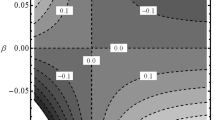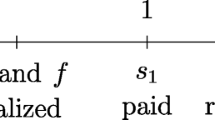Abstract
This paper considers incentive provisions for a manager who makes investment decisions. The manager's performance measure can be based on current accounting information: cash flow, depreciation, book value, and current investment. We argue that Residual Income is the unique (linear) performance measure that achieves goal congruence, i.e., the manager accepts all positive NPV projects, and only those. If the manager has the same discount rate as the owner, the depreciation rules remain indeterminate. However, if the manager's discount rate assumes potentially a whole range of values, then a particular depreciation policy combined with Residual Income is the unique way to achieve goal congruence.
Similar content being viewed by others
References
Anctil, R. (1996). “Capital Budgeting Using Residual Income Maximization.” Review of Accounting Studies1, 9–34.
Anctil, R., J. Jordan, and A. Mukherji. (1996). “The Asymptotic Optimality of Residual Income.” Review of Accounting Studies2, forthcoming.
Beaver, W., and R. Dukes. (1974). “Delta Depreciation Methods: Some Analytical Results.” Journal of Accounting Research12,205–215.
Bierman, H. (1961). “Depreciable Assets-Timing of Expense Recognition.” The Accounting Review36(1), 613–618.
Bodenhorn, D. (1961). “An Economist's Look at Industrial Accounting and Depreciation.” The Accounting Review36(1), 583–588.
Brief, R., and K. Peasnell. (1995). “Clean Surplus: A Link Between Accounting and Finance.” Forthcoming.
Ewert, R., and A. Wagenhofer. (1995). Interne Untemehmensrechnung.Berlin: Springer Verlag.
Feltham, G., and J. Ohlson. (1995). “Valuation and Clean Surplus Accounting for Operating and Financial Decisions.” Contemporary Accounting Research11(2), 689–731.
Feltham, G., and J. Ohlson. (1996). “Uncertainty Resolution and the Theory of Depreciation Measurement.” Jouml of Accounting Research34(2), 209–234.
Gonik. (1974). “Tie Salesmen's Bonuses to their Forecasts.” Harvard Business Review.
Govindaraj, S., and R. Ramakrishnan. (1996). “Accounting Earnings Process, Intertemporal Incentives and Its Implications for Valuation.” Working paper, Stern School of Business, New York University.
Ijiri, Y., C. Kinard and E B. Putney. (1968). “An Integrated Evaluation System for Budget Forecasting and Operating Performance.” Journal of Accounting Research6(1), 1–28.
Kaplan, R. (1982). Advanced Management Accounting.Englewood Cliffs, NJ: Prentice Hall Press.
Kirby, A., S. Reichelstein, P. K. Sen and T. Y. Paik. (1991). “Participation, Slack and Budget Based Performance Evaluation.” Journal of Accounting Research29(1), 109–128.
Kloock, J. (1981). “Mehrperiodige Investitionsrechnungen auf der Basis Kalkulatorischer und Handelsrechtlicher Erfolgsrechnungen.” Zeitschrift fiir Betriebswirtschaftliche Forschung,873–890.
Laux, H. (1995). Erjolgssteuerung und Organisation 1.Berlin: Springer Verlag.
Liicke, W. (1955). “Investitionsrechnung auf der Grundlage von Ausgaben oder Kosten?" Zeitschriftfitr Betriebswirtschaftliche Forschung,3 10–324.
Ohlson, J. (1995). “Earnings, Book Value and Dividends in Security Valuation.” Contemporary Accounting Research11(2), 661–687.
Ohlson, J. (1996) "Earnings, Book Values and Dividends in a Stewardship Setting with Moral Hazard.” Working paper, Graduate School of Business, Columbia University.
Preinreich. (1937). “Valuation and Amortization.” The Accounting Review12(3), 209–226.
Ramakrishnan, R. (1988). “Accrual Accounting and Incentives: Depreciation Methods for Investment Centers.” Working paper, Graduate School of Business, Columbia University.
Reichelstein, S. (1997). “Providing Mangerial Investment Incentives: Accrual Accounting versus Cash Flows.” Working paper, Haas School of Business, U.C. Berkeley.
Rogerson, W. (1993). “Inter-Temporal Cost Allocation and Managerial Investment Incentives, Version 1.” Working paper, Northwestern University.
Rogerson, W. (1996). “Inter-Temporal Cost Allocation and Managerial Investment Incentives, Version 2.” Working paper, Northwestern University. Forthcoming, Journal of Political Economy.
Solomons, D. (1965). Divisional Per$ormance Measurement and Control.Homewood, Illinois: Irwin.
Stewart, B. (1991). The Quest of Value.New York: Harper Collins Publishers.
Stewart, B. (1994). “EVA: Facts and Fantasy.” Journal ofApplied Corporate Finance,Summer.
Tully, S. (1993). “The Key to Creating Real Wealth.” Forrune Magazine128(6), 38–50.
Weitzman, M. (1976). 'The New Soviet Incentive Model.” Bell Journal of Economics7(1), 251–257.
Author information
Authors and Affiliations
Rights and permissions
About this article
Cite this article
Reichelstein, S. Investment Decisions and Managerial Performance Evaluation. Review of Accounting Studies 2, 157–180 (1997). https://doi.org/10.1023/A:1018376808228
Issue Date:
DOI: https://doi.org/10.1023/A:1018376808228




